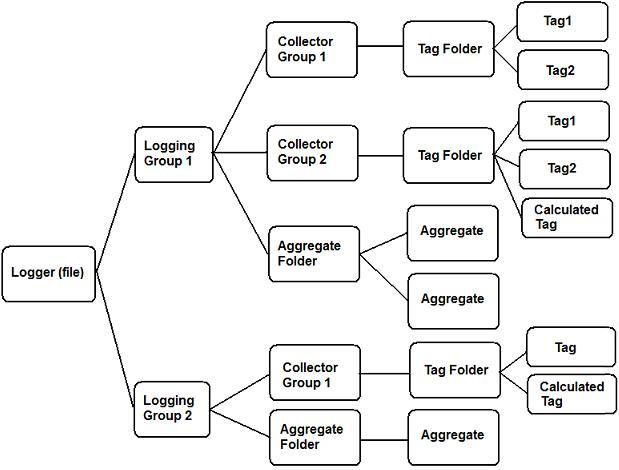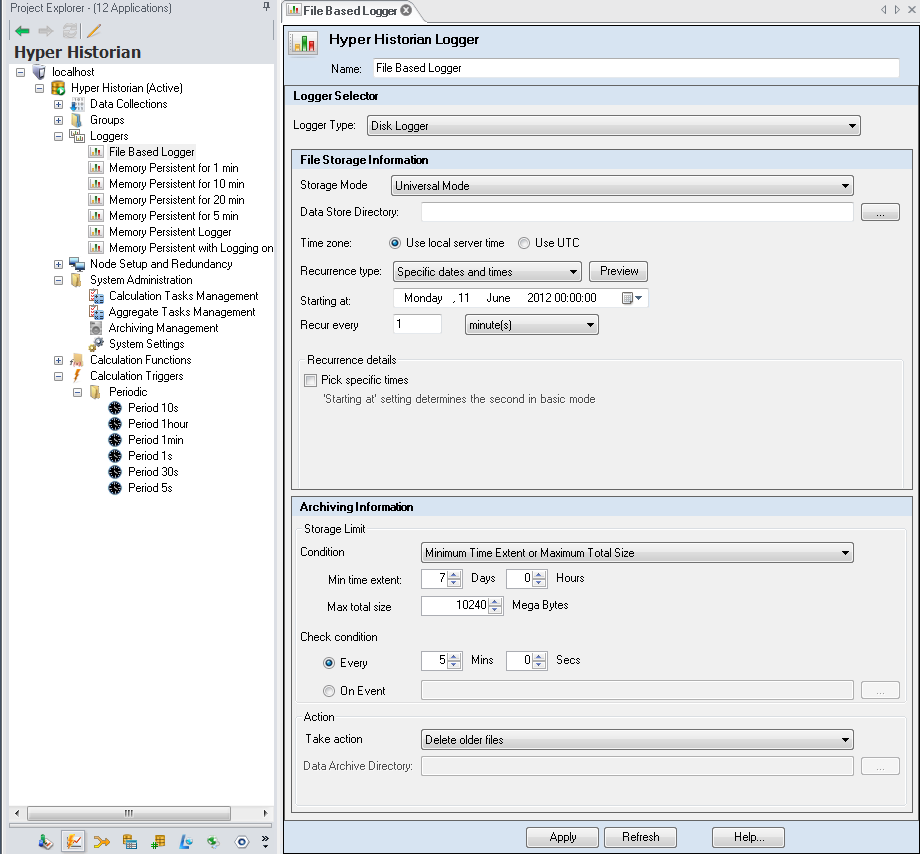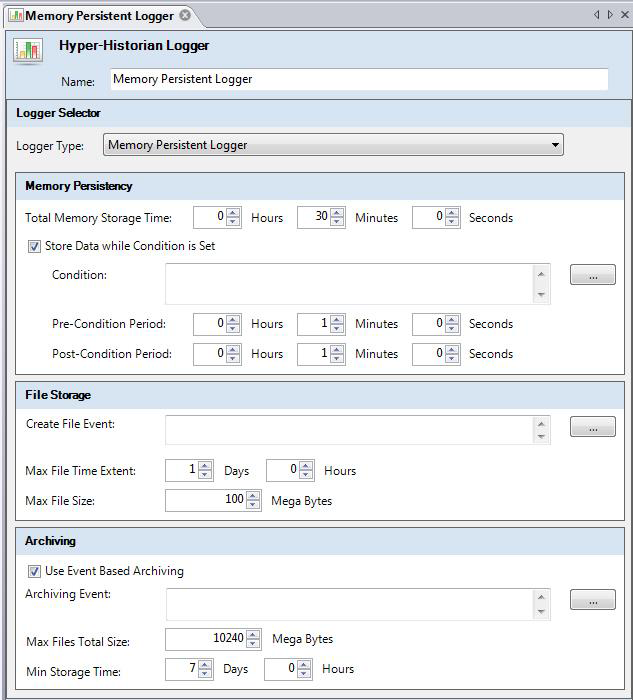The primary element for the grouping of tags is the Logger. For each Logger that is created, the Hyper Historian creates a series of similarly named binary files to hold the Plant Historical data. The file creation and automatic archiving functions are based on the Logger. You may create multiple Loggers.
Before you begin, you should analyze what data you want to collect and how long you want the data to be kept online in the Hyper Historian. Data that is kept online for longer periods of time should be grouped together in one Logger. Data that is to be kept online for shorter periods of time should be grouped in a second Logger, and so on. For example, if you desire to have some data kept online for a year, some data for three months, and some for one month, you should create at least three Loggers; one for each of the desired time ranges.
As illustrated below, a Logger is made up of one or more Logging Groups. Each Logging Group may contain one or more Collector Groups; collector groups are made up of Tags, whose data is to be logged, or Tag Folders that contain Tags (also called Hyper Historian tags) and Calculated Tags (described in the Calculated Tags topic). Each Logging Group also contains a folder called Aggregate, which Hyper Historian adds automatically to each logging group that you create; you can add any number of Aggregate Groups to this folder. Each Hyper Historian tag can reference the Logging Group's aggregates. (Aggregates are described in the Aggregate Groups topic.) Note that Logging Groups can be enabled or disabled via the Configurator, and can be enabled or disabled online as well.
Organizing Your Tags in Hyper Historian

A Hyper Historian logger can be defined to be either File Based or Memory Persistent. If the logger is File Based, all of its collected plant data is committed to the hard disk. If the logger is Memory Persistent, the collected plant data is stored in RAM memory and discarded after a pre-configured amount of time. The Memory Persistent Logger can be configured to store a portion of its collected data to the hard disk upon a condition (occurring in real time). An example of each type of Logger is included in the default Hyper Historian configuration (listed under the Loggers selection).
|
|
Note: If you chose to include examples when you created your configuration database, several sample Logging Groups appear in the logging group. If you see a Logging Group in the list that suits your needs, you can simply drill into the Collector Group (make sure the settings work for you) and add your tags. Otherwise, add your own persistent Logger, as described below.
Note: You can import collector node configuration information from an Excel spreadsheet, an XML file, or a CSV file. For more information, refer to the Importing and Exporting Hyper Historian Configurations topic. Once imported, you can edit imported information as needed. |
Hyper Historian loggers can be either File Based or Memory Persistent. One of each type is already listed under the Loggers selection upon installation and first use.
To add a new Logger:
Right-click the Loggers node and select the Loggers command.
On the Hyper Historian Logger Configuration form enter a name in the Name text box, then select the logger type from the Logger Type drop-down list. (Each type is described below in Disk File Logger and Memory Persistent Logger.) Each Logger creates a data file on the hard drive to store the collected plant data. The data file is created for Memory Persistent Loggers as well as for File Based loggers because of the feature that permits Memory Persistent logged data to be stored on the disk upon a condition.
Hyper Historian Logger Configuration Form

Complete the sections on the form. Refer to the discussions below for Disk File Logger and Memory Persistent Logger for more information.
Note that you can configure automatic archiving by setting the Minimum Time Extent and/or Maximum Total Size parameters for File Based (Disk) loggers or by setting the Max File Time Extent duration (in days and/or hours) of the file event/trigger and the Max File Size parameters for Memory Persistent loggers.
To specify the conditions that the Hyper Historian Logger should use, close the Logging file and start a new one. The conditions can be based on a time period, file size or a triggered event.
If you choose to create a Disk File Logger, you will need to specify the conditions for when the Hyper Historian should create a new data file and close the current, existing file. This is used to control the amount of plant data or the time frame for the plant data that should be logged to each file. The conditions can be based on a time period, a file size, or a Unified Data Manager triggered event.
To create an optional file based logger:
Specify the name and a logger type of Disk Logger.
Select a storage mode, either Universal Mode or Non-Redundant Mode. It is recommended that you use Universal Mode since data log files created in this mode contain values from a predictable and predefined range of time.
Define the Data Store directory.
If you choose to log data using the Universal storage mode:
Select the time zone (either the local server time or UTC) that the logger should use to determine when to create a new data log file.
In Recurrence type, select whether to have create a new data log file after a constant time interval has elapsed or at Specific dates and times.
In Starting at, select a date and time during which the logger should create the first data log file. Use the provided calendar to select a date, and enter a time in the format HH:mm:ss, where HH = an hour between 0 and 23, mm = minutes, and ss = seconds. The default date and time is today at midnight (00:00:00 or 12:00:00 AM).
|
|
Tip: If you are selecting a starting time and date that is almost the same as the default value, you can click the unit of time that you wish to adjust in the starting at box and press the up and down arrow keys to move ahead and back one unit of time. For example, you can click on the current day of the week and press the up arrow key to set the logging starting date to tomorrow. |
If you select time interval as the recurrence type for the logger, enter the amount of time that should elapse before the logger creates a new data log file. Use the arrow buttons or enter a number in each box to select the number of Days, Hours, Minutes, and Seconds. The default value is 1 day.
If you select specific dates and times as the recurrence type for the logger, enter the amount of time that should elapse before the logger creates a new data log file. Enter a value in the textbox and select a unit of time in the pulldown menu (either second(s), minute(s), hour(s), day(s), week(s), month(s), or year(s)). The default value is 1 minute.
If you select specific dates and times as the recurrence type for the logger, you can fine-tune the amount of time that should elapse before the logger creates a new data log file in Recurrence details. For example, if you selected 1 month in "Recur every" and The first, third Monday in "Recurrence details," the logger would create a new data file almost every other Monday (except for Mondays on the 29th, 30th, or 31st day of each month).
If you choose to log data using the Non-Redundant storage mode: Under File, you can define the Max Time Extent that should pass before the logger creates a new data log file, the Max Size that the current log file can become before the logger creates a new file, or a Create File Event, which is a trigger from the Unified Data Manager that determines when the logger should create a new file. If you set more than one of these options, a new file is created when any of the specified conditions are met.
Once a data file is closed, it can remain on the system and be a data source for the runtime trend display and for SQL queries. Eventually, the collected data will have to be detached from the system and moved to external storage to make room for new incoming plant data. The process of detaching the older data and moving it is called archiving.
Automatic archiving can be based on the age of the data, the size of the data files, or on a Unified Data Manager event. The Unified Data Manager can be used to schedule the archiving of files based on a calendar event (date and time of day). In addition, the Unified Data Manager can be used to trigger file closure based on an external event. To use a Unified Data Manager trigger to schedule or trigger the file archive, browse for the trigger using the ellipsis button ![]() on the right side or type in the specific trigger name.
on the right side or type in the specific trigger name.
The Max Files Total Size can also be used to trigger an archive. When the total size of the online (un-archived) data files reach the maximum, archiving will be triggered. The Min Storage Time is used to specify the minimum amount of data that should be kept online after the archive. Once you have set your desired File Based Logger parameters, you need to click the Apply button to enforce your settings.
Hyper Historian is a high performance data logger that captures information for your plant floor. However, you may need to collect data only when a certain events occur, or you just need data to "stick-around" for long enough of a period so that when you go in and out of runtime in the Trend Viewer, you can still see data for the past minute. The Memory Persistent Logger offers this ability. The Memory Persistent Logger gives your operators the information they need as they go in and out of runtime and also logs information when a certain event occurs.
NOTE: To enable archiving for all memory persistent loggers, refer to the Enable Archiving for all Memory Persistent Loggers topic.
If you choose to create a Memory Persistent Based Logger, you will need to specify:
The time period the collected data is to be kept in RAM memory.
The pre- and post-condition time period the data is to be saved to disk on condition, if the Save Data while Condition is Set feature is enabled.
The conditions under which the Hyper Historian is to create a new data file and close the current, existing file. The conditions can be based on a time period, file size or a Unified Data Manager triggered event.
To set up a memory-persistent logger, use the following parameters on the Memory Persistent Logger Configuration Form:
Hyper Historian Logger Memory Persistent Logger

Total Memory Storage Time. This is the amount of time that the logged data is kept in memory. Note that once this time expires, the data is discarded.
Store Data on Condition. Store Data on Condition is an optional feature of the Memory Persistent Logger. If enabled, it stores a pre-defined portion of the collected data to the disk upon a condition. The condition can be based on a Unified Data Manager Trigger. To select a Unified Data Manager trigger to trigger the data store, browse for the trigger using the ellipsis button ![]() on the right side or type in the specific trigger name. For more information, refer to the Unified Data Manager topic.
on the right side or type in the specific trigger name. For more information, refer to the Unified Data Manager topic.
In addition to specifying the Unified Data Manager Conditional trigger, you must set the Pre-Condition and Post-Condition time period (in hours, minutes or days) for the data that should be saved to disk when the conditional trigger occurs.
File Storage Information. You will need to specify the conditions for when the Hyper Historian should create a new data file and close the current, existing file. The conditions can be based on a time period, file size or a Unified Data Manager triggered event.
The Unified Data Manager can be used to schedule the creation and closing of files based on calendar (date) and Time of Day. In addition, the Unified Data Manager can be used to trigger file closure based on an external event. You also must set the maximum file time (in days and/or hours) and the maximum file size (in megabytes).
Once a data file is closed, it can remain on the system and be a data source for the runtime trend display and for SQL queries. Eventually, the collected data may have to be detached from the system and moved to external storage - to make room for new incoming plant data. The process of detaching the older data and moving it is called archiving.
Automatic Archiving can be based on the age of the data, the size of the data files or on a Unified Data Manager event. The Unified Data Manager can be used to schedule the archiving of files based on a calendar event (date and time of day). In addition, the Unified Data Manager can be used to trigger file closure based on an external event.
To use a Unified Data Manager trigger to schedule a trigger that saves the file archive:
Enable the Use Event Based Archiving check box.
Browse for the trigger using the ellipsis button ![]() on the right side of the Archiving Event text box, or type in the specific trigger name and enter that trigger into the Archiving Event text box.
on the right side of the Archiving Event text box, or type in the specific trigger name and enter that trigger into the Archiving Event text box.
Set the parameters for the archive; then click the Apply button.
The Max Files Total Size can also be used to trigger an archive. When the total size of the online (un-archived) data files reach the maximum, archiving will be triggered.
The Min Storage Time is used to specify the minimum amount of data that should be kept online after the archive.
Before deleting a Hyper Historian Logger, you should first verify that there are no Logger Groups using the Logger that is to be deleted. If any Logger Groups are assigned to the Logger, they need to be deleted or assigned to another Logger first.
|
|
Warning: Once you delete a Logger, the data that was previously logged as part of the group will no longer be available for playback to the trend display nor available in the SQL Query Interface. |
To delete a logger:
Right-click the desired item, then select the Delete command from the context menu.
Confirm the deletion in the dialog box that appears.
See also: